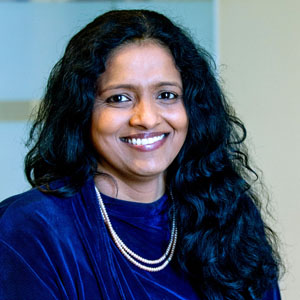Most physicians would choose a "no-code" status for themselves if they were terminally ill, but would tend to pursue aggressive treatment for patients facing a similar prognosis
May 28, 2014 - By Tracie White

Most physicians would choose a do-not-resuscitate or “no code” status for themselves when they are terminally ill, yet they tend to pursue aggressive, life-prolonging treatment for patients facing the same prognosis, according to a study from the Stanford University School of Medicine.
It’s a disconnect that needs to be better understood, said VJ Periyakoil, MD, clinical associate professor of medicine and lead author of the study, which was published May 28 in PLOS ONE.
“Why do we physicians choose to pursue such aggressive treatment for our patients when we wouldn’t choose it for ourselves?” said Periyakoil, director of the Stanford Palliative Care Education and Training Program. “The reasons likely are multifaceted and complex.”
In the study, Periyakoil and her colleagues set out to determine how physicians’ attitudes have changed toward advance directives since passage of the Self-Determination Act in 1990, a law designed to give patients more control over determining end-of-life-care decisions. Advance directives are documents that patients can use to indicate end-of-life care preferences.
The study involved two sets of subjects: One comprised 1,081 physicians who in 2013 completed a web-based advanced directive form and a 14-item advance directive attitude survey at Stanford Hospital & Clinics and the Veterans Affairs Palo Alto Health Care System; the other comprised 790 physicians from Arkansas who were asked the same 14 survey questions — but did not complete an advance directive form — in a 1989 study published in the Journal of the American Medical Association.
Surprisingly, results showed that doctors’ attitudes toward advance directives have changed little in 25 years.
“The needle has not moved very much,” Periyakoil said, who is also associate director of palliative care services at the Palo Alto VA center.

A survey shows that physician attitudes toward advance directives haven't changed much since the passage of a 1990 law giving patients more control over their end-of-life care decisions.
The wish to die at home
A survey shows that physician attitudes toward advance directives haven't changed much since the passage of a 1990 law giving patients more control over their end-of-life care decisions.
The lack of change in physicians’ attitudes toward advance directives mirrors what the study describes as the medical system’s continued focus on aggressive treatment at the end of life, despite the fact that most Americans now say they would prefer to die at home without life-prolonging interventions.
“A big disparity exists between what Americans say they want at the end of life and the care they actually receive,” the study said. “More than 80 percent of patients say that they wish to avoid hospitalizations and high-intensity care at the end of life, but their wishes are often overridden.”
In fact, the type of treatments they receive depends not on the patients’ care preferences or on their advance directives, but rather on the local health-care system variables, such as institutional capacity and individual doctors’ practice style, according to the study.
“Patients’ voices are often too feeble and drowned out by the speed and intensity of a fragmented health-care system,” Periyakoil said.
Other results from the study showed that because of the Self-Determination Act, doctors now feel they are less likely to be sued for not providing the most aggressive care if a patient has an advance directive. The law requires hospitals to inform patients about advance directives, but it doesn’t ensure that the directives be followed.
Physicians’ attitudes toward end-of-life care also differed depending on their ethnicity and gender. Emergency physicians, pediatricians, obstetrician-gynecologists and those in physical medicine and rehabilitation had more favorable attitudes toward advance directives. Radiologists, surgeons, orthopaedists and radiation oncologists were less favorable. Caucasian and African American doctors were the most favorable; Latino physicians were the least favorable.
An overwhelming percentage of the 2013 doctors surveyed — 88.3 percent — said they would choose “no-code” or do-not-resuscitate orders for themselves.
Actions, not words, rewarded
As a geriatrics and palliative care physician who sits at the bedside of sick patients herself, Periyakoil said she understands the disconnect between the type of care doctors want for themselves at the end of life and what they actually do for their patients. It’s not because doctors are trying to make more money or because they are intentionally insensitive to their patients’ desires. At the core of the problem is a biomedical system that rewards doctors for taking action, not for talking with their patients.
“Our current default is ‘doing,’ but in any serious illness there comes a tipping point where the high-intensity treatment becomes more of a burden than the disease itself,” said Periyakoil, who trains physicians in palliative medicine. “It’s tricky, but physicians don’t have to figure it out by themselves. They can talk to the patients and their families and to the other interdisciplinary team members, and it becomes much easier.
“But we don’t train doctors to talk or reward them for talking. We train them to do and reward them for doing. The system needs to be changed.”
Other Stanford authors included analyst Eric Neri; Ann Fong, critical care pharmacist at Stanford Hospital & Clinics; and Helena Kraemer, PhD, professor emerita of psychiatry and behavioral sciences.
The research was supported by the National Institutes of Health (grants RCA115562 and R25MD006857) and the Department of Veterans Affairs.
Information about Stanford’s Department of Medicine, which also supported the work, is available at http://medicine.stanford.edu.
About Stanford Medicine
Stanford Medicine is an integrated academic health system comprising the Stanford School of Medicine and adult and pediatric health care delivery systems. Together, they harness the full potential of biomedicine through collaborative research, education and clinical care for patients. For more information, please visit med.stanford.edu.